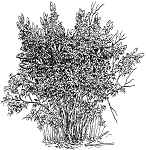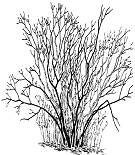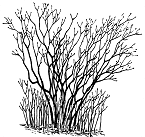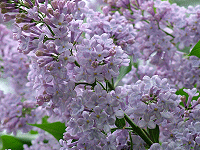Lilacs require a minimum of care, once established. If weeds grow close to the base, they should be removed and the area mulched. Don’t plan to cultivate close to the stem because the feeding roots are near the surface. During drought periods (leaves wilt), lilacs will respond favorably to supplemental water but established plants can stand a lot of dryness, especially later in the season, without permanent damage.
Pruning
Pruning is unnecessary for the first five years. After that, pruning one or more of the oldest stems clear to the ground each year will slowly and continually rejuvenate the bush and keep it from becoming excessively tall. Some sucker growth is good (on own rooted plants) because it will provide new stems for rejuvenation, allowing the bush to spread out to the final desired size, and produce propagation material for additional lilac plants to use in other places. If there are too many suckers, the ones furthest away can be removed either by hand (a sharp spade or an asparagus knife works well) or with a lawn mower if they come up in open ground. Leave several stems in the center of the clump. Then when a stem is removed because it is too tall or diseased, the flower display will not be affected.
REMEMBER: PRUNING OF LILACS SHOULD OCCUR AT THE BASE OF THE LILAC STEM AND AFTER BLOSSOM.
How to properly prune a lilac...
- Count the largest stems in your lilac clump and divide by three. (Figure 1)
- Remove one third of that number the first year, the second third the next year, and the Final Product remainder the third year.
- Cut at the base. (Figure 2)
- Let the sprouts remain.
- Prune after blossom has past.
- Mulch around lilac clump. (Figure 3)
- Resume the pruning process when you feel the shrub has one again become too dense or too tall.
 |
 |
 |
| Figure 1 | Figure 2 | Figure 3 |
|---|
Plant Health
 Some newly set plants may die during the first year (total should not exceed 10%) so the initial plan should include provision for review after the first year. At that time, plant health can be checked as well as site problems such as drainage and surface conditions such as weeds or need for additional mulch. Follow up care can make the difference between success and failure of a planting.
Some newly set plants may die during the first year (total should not exceed 10%) so the initial plan should include provision for review after the first year. At that time, plant health can be checked as well as site problems such as drainage and surface conditions such as weeds or need for additional mulch. Follow up care can make the difference between success and failure of a planting.
Bacterial wilt may appear in the spring if the weather is cool and wet or if the plant is in a site with poor air circulation. It shows up as dark brown or black edges on young leaves or as a sudden wilting of an entire branch just about bloom time. Normally, nothing needs to be done other than removal of the affected branches (although the pruning shears should be dipped in alcohol to prevent transfer of the disease to healthy wood). If a specific bush shows injury several years in a row, it might be useful to try moving it to a more open spot and substitute a different variety in the trouble spot since there are varietal differences.
Two scale insects that suck plant juices are the Oystershell scale and San Jose scale. A serious infection can weaken a lilac. A dormant oil spray on the warm day (above 60 degrees) in May will kill all stages of the insect while most contact insecticides such as Malathion or Sevin applied in June will get the young insects as they crawl onto the new growth. Applications should be repeated as necessary. If there is a real serious problem with scale another spraying can occur in late August or early September.
Lilac borers may become a problem, especially in large plantings. The action of borers is to interrupt water movement and frequently the first sign is a wilting of one or more branches. Confirmation of borer activity is often a little pile of "sawdust" at the base of the stem. There are a variety of physical controls (e.g., a flexible wire inserted in the burrow) and chemical treatments but the best and easiest response is to develop a shrub with several stems so that if borers appear, the whole stem (and its borer) can be removed and destroyed.
Powdery mildew is the most common fungus disease of lilacs. It covers the leaves with whitish, felt-like patches of fungus although it is usually not visible until late in the season. It is a superficial disease that does not grow beyond the leaf surface layer. Also, since it does not occur in large amounts until late in the season it does not affect the development of next spring’s buds nor the food storage necessary for good growth and bloom next year. Therefore the plants will survive very well with no treatment at all.
There are some cultural things that can be used to reduce the amount of mildew since it grows best in shady, damp situations. Placing lilacs in full sun locations where there is a good air circulation will reduce the growth of the fungus. Less mildew will appear in dry years than in seasons with a long damp fall. There are also variety differences and some are affected much more than others. Among the late blooming lilacs, a number such as those introduced from the University of New Hampshire, are very resistant and do not develop mildew at all in cool climate locations.
Chemicals exist which will control mildew even on very susceptible varieties but treatment must be started at the very first sign of the disease and repeated at 10 day intervals through the rest of the season. This represents a considerable effort so it is recommended only for plants in position where they will be observed close up or are very important plants. Names and dosage rates recommendations can be obtained from the county extension staff or knowledgeable people in garden centers/nurseries.
Lilacs respond vigorously to regular, liberal amounts of fertilizer. One to two large handfuls (depending on the size of the bush) of a 5-10-5 granular fertilizer per year will enhance growth and flowering. Chemical fertilizers should be applied in early spring before growth has begun. Broadcast it directly on top of the soil, distributing it evenly around the root zone. If slow release or organic fertilizers are used, they may be applied at any season.
Dolomitic limestone is also beneficial in regions of high acidity (pH 3.5-5.5) but not needed if the pH is in the range suitable for general garden use (pH 6.0-6.5). In much of New Hampshire, a handful of limestone every second or third year will improve growth by keeping the soil from becoming too acidic.
Competition from trees and shrubs that have invaded a clump of lilacs will have an adverse effect on the bloom and vigor of the lilac plants. The unwanted trees and shrubs require diligent cutting back to ground level to discourage these invaders. Treating the stumps after cutting with a stump control herbicide is the ideal method of permanently removing the unwanted growth. At the present time stump control herbicides are restricted and require a pesticide license to purchase and use. By keeping the lilac clump in vigorous growth many tree seedlings can be discouraged from sprouting within the clump.
Competition can also come from nearby tall shrubs and low tree limbs that shut out sunlight. Reducing the height of the interfering shrubs and removing some tree limbs can make a greater amount of sunlight available to the lilac plants.
